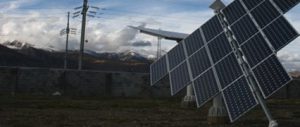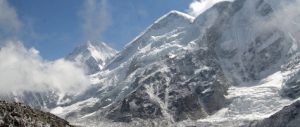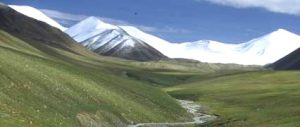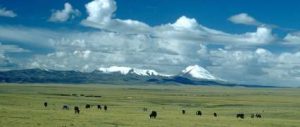The warming climate is changing the environment in the Himalayas faster than any other region of the world. The mighty glaciers of the world’s highest mountains – the source of most large Asian rivers, including the Indus, the Ganges and the Nu (Salween) – are melting.
Against these dramatic changes, the governments of India, Pakistan, Nepal and Bhutan are planning to transform the Himalayan rivers into the powerhouse of south Asia. They want to build hundreds of mega-dams to generate electricity from the wild waters of the Himalayas. With over 150,000 megawatts (MW) of additional hydropower capacity proposed in the next 20 years across the four countries, the Himalayan region could potentially have the highest concentration of dams in the world.
While a high concentration of large dams will challenge the integrity of river basins and the livelihoods that depend on them, a dam building boom in the Himalayas could have a range of unforeseen consequences due to climate change.
Global warming will cause glaciers to melt, river waters to rise and increase the risks of storms and floods. The water situation in the Himalayas will change drastically: past seasonal and regional trends will no longer be a good measure to predict future water flows; these flows will change in each and every Himalayan river.
What does this mean for dam building in the region? When planning hydropower projects, some of the most crucial data is about river flow. However, with melting glaciers in the Himalayas, historical river flows are no longer a good measure for future flows. Climate change has destroyed the certainty that future river flows will be similar to past flows.
This uncertainty makes it incredibly risky to build dams. The extent of the predicted storms is not known, the seasonal distribution of waters is no longer certain. Nobody can predict when the waters in the rivers will rise, how much they will rise and for how long. Moreover, no one knows when the glaciers will eventually have melted – and no longer can provide any water to the rivers at all. We only know that the melting of the glaciers in the Himalayas will result in an initial increase and then a decline of water flows in the Himalayan rivers.
The data needed to build hydropower projects in the Himalayas is not available. It is not clear how often the dam gates of any planned dam in the Himalayas will have to be left open in order to allow for extremely high floods to rush through its gates (all the while not generating any power). Storms, strong rains and floods, which are predicted to increase with the warming climate, can also threaten the very existence of dam walls and can destroy even the most robust mountains of concrete planned in the Himalayas.
Shripad Dharmadhikary, in his report “Mountains of Concrete: Dam Building in the Himalayas”, has shown that the plans for most dams in the Himalayan region do not take the likely impacts of climate change on the Himalayan rivers into account. Dharmadhikary says: “Unfortunately, none of these risks are being considered in the dams planned for the Himalayas – neither for individual dams, nor cumulatively”.
The governments of the region, eager to make the dam-building boom happen, focus on the expected benefits while turning a blind eye to the uncertainties of global warming. “Hydro-dollars” are on the minds of the governments of Nepal and Bhutan, who want to build the large dams to earn revenues from the sale of electricity to India. India itself is eager not only to buy hydropower from its neighbours, but also to generate it in the mountainous regions of the country.
Nepal currently finds itself in a severe energy crisis, with a shortage of petroleum fuels and only 40% of the rural population with access to electricity. However, most of the large dams in the country are planned for the export of electricity to India. Among the big projects planned for the immediate future, West Seti, Upper Karnali and Arun III are all meant to sell electricity to India, with only a small percentage of that power being set aside for Nepal.
It comes as no surprise that these large dams face opposition from the residents they will displace. But some in Nepal also explain that the country will not even gain “hydro-dollars” from projects such as West Seti. Ratna Sansar Shresthar, a Nepali lawyer and financial analyst, explained that since the project is being built by foreign corporations, Nepal will not see much of the expected profits. “Since most of the project’s equity comes from overseas – except for the government’s 15% share – only 15% of the dividend will come to Nepal,” said Shresthar. “Another major outlay is the repayment of a part of the principal and interest. As the project is borrowing from foreign agencies, these payments will never enter Nepal.” The promises of high revenues for Nepal are therefore likely to remain unfulfilled.
In India, the basic driver for hydropower is the demand for electricity. The country continues to be plagued by power and energy shortages. Overall, peak power demand over 2007 was 108,886 MW, of which only 90,793 MW were met – a shortfall of over 16%.
Moreover, a large portion of the Indian society does still not have access to electricity. The government says that in 2006, one in four Indian villages was still without access to electricity.
However, it is not clear that a lack of access to electricity can be blamed solely on the country’s lack of generation capacity. India’s electricity grid is known for its huge transmission and distribution losses of between 35% and 45%. Recent increases in electricity costs for private consumers, as well as the reduction of subsidies, have further reduced poor people’s access to the grid.
More hydropower capacity will not necessarily increase people’s access to electricity. Since most of the projects are planned at high altitudes, they will be costly and so will the electricity that they generate.
The 4,500-MW Diamer-Bhasha Dam on the Indus in Pakistan, with a price tag of US$12.6 billion, is the most costly dam planned for the Himalayan region. While the government of Pakistan has been working for more than two years to find funders for the project, its finances are still on shaky grounds. In November 2008, Pakistan’s National Economic Council approved US$1.5 billion toward the construction of the dam, and Pakistan’s minister for water and power declared that Chinese companies would build the dam and “some Arab countries” would provide part of the financing. Around the same time, the World Bank refused to provide any funding for the project, dealing a severe blow to the government’s attempts to find foreign backers. In response to this decision, the minister was quoted as saying that several alternative avenues for funding the project would have to be sought, including private sector loans and a surcharge on electricity.
The Diamer-Bhasha Dam is not the only project that lacks clear funding commitments and forces the government to try to find alternatives to traditional funders that used to provide the bulk of the funds for hydropower.
In India, traditional funders are also taking a back seat and Indian financial institutions, as well as Indian public sources, are playing larger roles. But the financial gap is still huge; with the current global financial crisis, the appetite for funding large dams might be further diminished. Dharmadhikary shows in his report that over 40% of the funds needed for the Indian government’s Eleventh Five-Year Plan for the power sector are still lacking.
Global warming might be the most serious challenge to the safety and efficiency of the proposed dams in the Himalayan region, but the funding gap appears to be hampering India and Pakistan moving ahead with the largest planned dams for the region, including the Diamer-Bhasha project. It also appears that strong local opposition to some of the major projects, including the West Seti project and the 3,000-MW Dibang project in Arunachal Pradesh, India, constitute larger obstacles for the project planners than anticipated. Planned public hearings for the Dibang project have had to be cancelled several times due to strong opposition, and the government of Sikkim has announced it will scrap four planned projects on the Teesta River, in response to local opposition.
Opposition to the projects testifies the low degree of participation of affected people in the relevant decision-making processes – and the lack of consideration for the social and environmental impacts of the planned dams. Dharmadhikary’s analysis also testifies to the lack of consideration for climate-change issues in the planning processes. He writes: “Pushing ahead such a massive dam-building program in the fragile Himalayan region without proper social and environmental assessments and safeguards, and ignoring the likely impacts of climate change, can have severe consequences.
“All of these things point to the need for a comprehensive review of the dam building program in each of the river basins in the Himalayas.”
Ann-Kathrin Schneider is South Asia programme director and policy analyst at International Rivers. Schneider holds a Master’s degree in Development Studies from the School of Oriental and African Studies in London. Her work focuses on monitoring and challenging the activities of international financial institutions such as the World Bank and private banks.
Homepage photo by International Rivers/Yuki Tanabe





